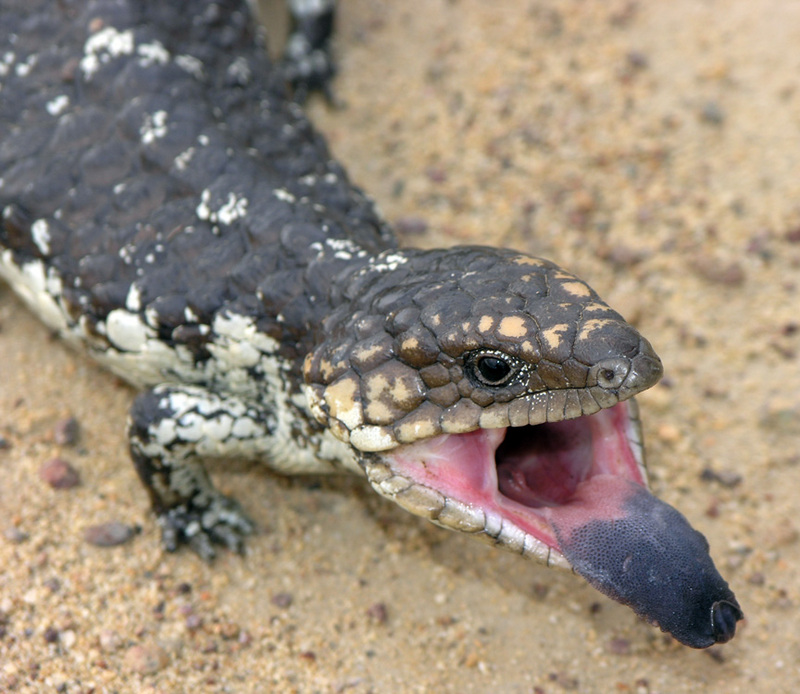|
| Query: Tongue snail | Result: 6th of 14 | |
Blue-tongued Lizard (Tiliqua sp.) - Wiki
| Subject: | Blue-tongued Lizard (Tiliqua sp.) - Wiki
| |

| Resolution: 864x750
File Size: 235164 Bytes
Date: 2005:05:01 05:23:50
Camera: C8080WZ (OLYMPUS CORPORATION)
F number: f/3.4
Exposure: 10/3200 sec
Focal Length: 356/10
Upload Date: 2007:01:23 01:26:16
|
Blue-tongued lizard
From Wikipedia, the free encyclopedia
[Photo] Genus: Tiliqua. (Original description: "This is an image I took myself using an Olympus C8080W digital camera. It shows a blue tongued lizard, taken in Merredin, Western Australia.") Date: 1 May 2005. Taken by en:User:SeanMack http://en.wikipedia.org/wiki/User:SeanMack
Blue-tongued lizards, also known as bluetongue skinks, are one of the largest members of the skink family. As suggested by its name, its distinguishing characteristic is a blue tongue. There are six species of blue-tongues which occur in Australia. An insular subspecies of Tiliqua scincoides is found on several small Indonesian islands between Australia and New Guinea. A distinct species, Tiliqua gigas, occurs in various areas of Indonesia, particularly the island of New Guinea. There are four subspecies of the shingleback skink. All species, with the exception of pygmy blue-tongues, are relatively large (30-60 cm total length), heavy-bodied, short-limbed, broad with a distinct head, and short, tapered tail.
- Tiliqua adelaidensis Pygmy Blue-Tongued Skink
- Tiliqua gigas gigas Indonesian Blue-Tongued Skink
- Tiliqua multifasciata Central Blue-Tongued Skink
- Tiliqua nigrolutea Blotched Blue-Tongued Skink
- Tiliqua occipitalis Western Blue-Tongued Skink
- Tiliqua rugosa Shingleback Skink
- Tiliqua scincoides scincoides Eastern Blue-Tongued Skink
- Tiliqua scincoides intermedia Northern Blue-Tongued Skink
- Tiliqua scincoides chimaerea Tanimbar Blue-Tongued Skink
These lizards occupy a range of habitats from desert, semi-arid savannah, woodland and temperate suburban areas through to tropical jungle. They are omnivorous, and may feed on berries, flowers and other plant material, fungi, insects, spiders, or other small animals, carrion, and are very partial to snails and slugs. They may grow up to 60 cm (depending on the species). Solitary for most of the year, mating occurs in September-November. Pair bonding may occur over successive years (Bull 1988). The young are born (live) 3-5 months after mating (December-April). Litters may have 5-18 individuals. Predators include kookaburras, raptors, and snakes (e.g. Pseudonaja textilis, Mulga snake) (Valentic 1996). Dogs and cats have also been known to attack bluetongues in a surburban environment. When a blue-tongue is threatened it will face the threat opening its mouth wide, sticking out its blue tongue in an attempt to scare away the threat.
Captivity & Pet Care
The blotched and eastern blue-tongued lizards make great, low maintenance pets, and if hand-raised, have a great temperament. Some specimens have lived for thirty years in captivity. In Australia, it is illegal to be in possession of a Blue Tongued lizard without a Class 1 Reptile Keeper's License, as per the requirements of the National Parks and Wildlife Service. Obtaining a license is easy; on the other hand, possessing a skink without a license, or capturing one from the wild, can result in heavy fines and imprisonment. In the US none of the species require a permit to keep in captivity.
Trivia
The blue-tongued lizard serves as the mascot for the Brisbane Blue Tongues, an ice hockey team which plays in the AIHL.
A Hunter Valley company has started to produce beer, including ginger beer under the name "Bluetongue", and has sponsored the Bluetongue Central Coast Stadium, home ground of the Central Coast Mariners FC.
http://en.wikipedia.org/wiki/Blue-tongued_lizard
| The text in this page is based on the copyrighted Wikipedia article shown in above URL. It is used under the GNU Free Documentation License. You may redistribute it, verbatim or modified, providing that you comply with the terms of the GFDL. |
|
Comments |
|---|
| | Guest |
|
| lljhlflnhl |
| | Guest |
|
| is this the blue tongue lizard |
| | Trouble |
|
| Umm, I think you're mistaken... this is a shingleback skink... quiet commonly mistaken for a blue tongue skink. |
| | Lizard man |
|
| that lizard is awesome |
^o^
Animal Pictures Archive for smart phones
^o^
|
|
|

